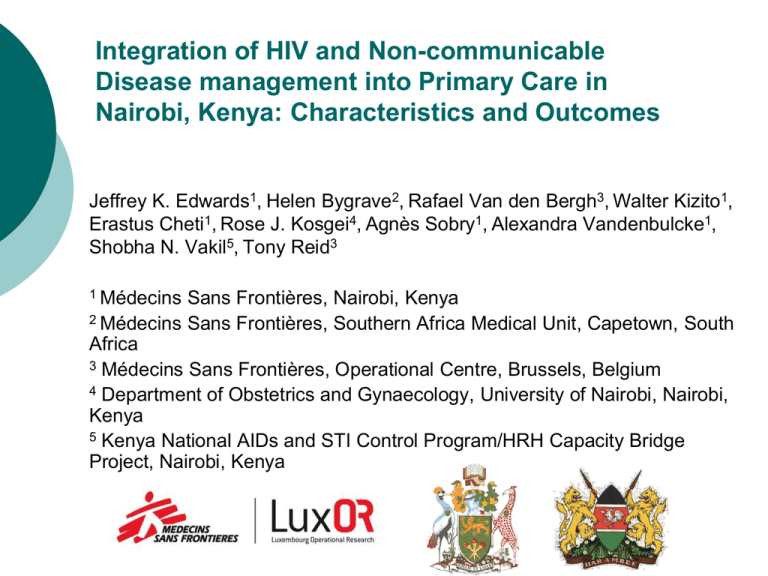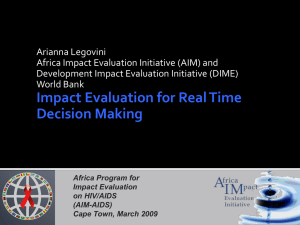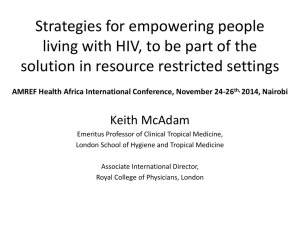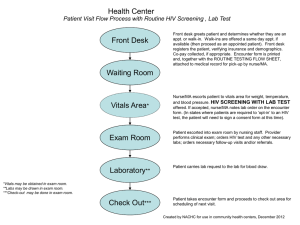TUAB033 – Integration Of Hiv And Non
advertisement

Integration of HIV and Non-communicable Disease management into Primary Care in Nairobi, Kenya: Characteristics and Outcomes Jeffrey K. Edwards1, Helen Bygrave2, Rafael Van den Bergh3, Walter Kizito1, Erastus Cheti1, Rose J. Kosgei4, Agnès Sobry1, Alexandra Vandenbulcke1, Shobha N. Vakil5, Tony Reid3 1 Médecins Sans Frontières, Nairobi, Kenya 2 Médecins Sans Frontières, Southern Africa Medical Unit, Capetown, South Africa 3 Médecins Sans Frontières, Operational Centre, Brussels, Belgium 4 Department of Obstetrics and Gynaecology, University of Nairobi, Nairobi, Kenya 5 Kenya National AIDs and STI Control Program/HRH Capacity Bridge Project, Nairobi, Kenya BACKGROUND – NON-COMMUNICABLE DISEASES Non-communicable diseases (NCD) were declared a neglected global health issue by WHO in 2005 Globally, the burden of NCD is increasing yearly NCD health care needs remain unmet, especially in resource-constrained settings such as Kibera: need for well defined integrated models of primary care lack of access to services lack of adequately trained staff & NCD guidelines medications remain expensive follow up is a major challenge BACKGROUND: MSF Context The Kibera slum in Nairobi, Kenya, is characterized by poverty, poor sanitation, and a highly mobile population Such populations are vulnerable for NCD's, such as hypertension (HTN) and diabetes mellitus (DM), inaddition to HIV BACKGROUND: NEW FOR MSF In 2010, MSF integrated NCD care with the existing HIV programme in three primary health care clinics in the Kibera slum DESCRIPTION – PACKAGE OF CARE The main components of the programme included: A holistic team of health staff (clinical officers, nurses, nutritionists, health educators, social workers and adherence counsellors) Offer of a package of care (clinical care, nutritional and social support, and education on life style measures, diseases and treatment) Cohort outcome data monitoring OBJECTIVE To describe the characteristics and outcomes of patients with NCDs (hypertension and/or diabetes) with or without HIV To assess whether the patients’ health can be improved through an integrated model of primary care METHODS Study site: three MSF-supported clinics in Kibera Study period: January 2010-June 2013 Study population: all patients ≥ 15 years diagnosed with HTN and/or DM: HTN: BP (>140/90) measurements recorded during two or more clinic visits DM: fasting blood sugar ≥7.0 mmol/l Routinely collected data extracted from a program database Ethics clearance from Kenya Medical Research Institute and MSF Ethics Review Board RESULTS Patient characteristics at enrolment into chronic disease cohort Clinical Characteristics Male Female HIV+ HIV– HIV+ HIV– 66 (10) 573 (90) 144 (9) 1423 (91) Median age years (IQR) 45 (39-53) 53 (46-60) p<0.0001 43 (38-50) 47 (40-54) p<0.001 BMI (kg/m2) 22 (20-24) 24 (20-26) p=0.02 25 (22-28) 28 (24-32) p<0.0001 Systolic BP (mm Hg, IQR) 154 (137167) 160 (146178) p=0.002 151 (136161) 160 (142177) p<0.0001 Diastolic BP (mm Hg, IQR) 97 (86-105) 99 (89-108) 97 (89-106) Number patients (%) n=2,206 100 (90-110) p=0.006 RESULTS Patient diagnosis at enrollment into chronic disease cohort Male Diagnosis Female HIV+ HIV– HIV+ HIV– Hypertension (stages 1-3*) 61 477 p=0.004* 139 1220 p<0.001* Diabetes (type 1 & 2*) 5 96 5 203 p=0.008* Chronic Kidney Disease-concurrent (CrCl < 60 ml/min) 7 94 23 142 RESULTS Characteristics of people living with HIV in chronic disease cohort Characteristic Male (IQR) Female (IQR) Median age (years) at HIV programme enrollment 43 (36-50) 40 (34-46) Median CD4 count at NCD programme enrollment 476 (339-578) 442 (305-554) Median years in HIV programme 4 (3-6) 5 (3-7) Median years on ART 4 (3-6) 4 (2-6) RESULTS Chronic kidney disease within the cohort The frequency of chronic kidney disease (CKD = creatinine clearance < 60 ml/min) in the combined cohort was 15% (266/1802) There were no differences between the frequency of CKD in people living with HIV (PLHIV) vs. those without HIV. Of those with CKD within the cohort, 15% (41/266) had concurrent Type 1 or 2 diabetes mellitus. There was no association found between the use of tenofovir and CKD among PLHIV. The median age for those with PLHIV and CKD was 47 (IQR 4154) vs. 59 (49-70) years without HIV (p < 0.0001). RESULTS Selected outcomes from the chronic disease program, 2010-2013 Male Outcomes (median) Systolic BP at last visit HIV+ (IQR) Female HIV– (IQR) HIV+ (IQR) HIV– (IQR) 144 (133-155) 148 (131-161) 143 (129-157) 143 (126-156) Diastolic BP at last visit 90 (79-97) 88 (80-96) 90 (81-98) 88 (79-96) Last HbA1c in diabetics 9 (7-10) 9 (7-11) 8 (5-12) 9 (7-11) Last total cholesterol in diabetics 5 (5-6) 5 (4-6) 6 (5-7) 5 (4-6) 18/66 (27) 249/573 (44) p=0.02 34/144 (24) 521/1423 (37) p=0.002 Number lost to follow up after 6 months or longer (%) LIMITATIONS Short-term monitoring of 3.5 years: no possibility to assess reduction in morbidity and mortality Poor documentation of complications at baseline and during follow up Strengths This study provides a “real world” assessment of an integrated primary care program from an informal settlement Standardized treatment protocols were used for hypertension, diabetes, CKD and HIV that were aligned with international guidelines Program was primarily run by clinical officers and nursing staff Routine data monitoring was completed CONCLUSIONS This study highlights the need to recognize the increasing chronic disease burden in sub-Saharan Africa. PLHA appear to be at higher risk of developing concurrent NCDs at a younger age, and would benefit from routine surveillance for them. It is possible to integrate both HIV and NCD care together in a primary care programme This integrated programme can be run by clinical officers and nursing staff within significant resource constraints. ACKNOWLEDGEMENTS A special thanks to the whole Kibera staff for their work and dedication This research was supported through the Médecins Sans Frontières, Brussels-Luxembourg Operational Research Unit Médecins Sans Frontières-Operational Centre Brussels brought technical support and complementary programme funds THANK YOU




